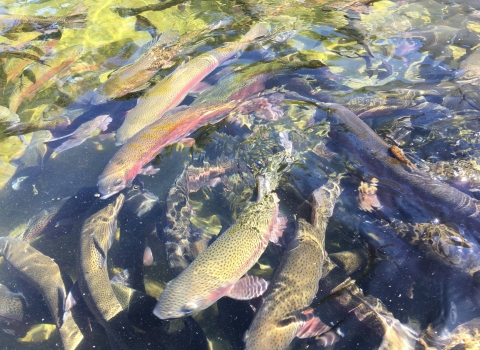Federal officials optimistic that Yreka phlox can recover
A draft recovery plan for the endangered Yreka phlox (Phlox hirsuta) was published in todays Federal Register, outlining actions that are believed necessary for the recovery of one of Californias rarest plants.
Public comment on the proposed plan will be taken until close of business on October 17, 2004.
The Service listed the Yreka phlox as an endangered species on February 3, 2000. The plant also is on the State of Californias endangered species list. Botanists know of only four locations where the plant is found, all on serpentine slopes. Serpentine, Californias official state rock, breaks down into unusual soils that are high in magnesium and iron, and low in calcium and other nutrients, a mixture that is toxic to most plants, but can produce unique plant communities. These kinds of soils support more than 200 species of California native plants.
The pink flowers of Yreka phlox are similar to other native phlox species in the area, but Yreka phlox have unique hairy stems and leaves during spring and summer. Yreka phlox is found on lands owned and managed by industrial timber companies and other private landowners, the U.S. Forest Service, California Department of Transportation, and the City of Yreka. Activities on private lands, such as construction of fences, livestock water ponds, and livestock grazing, continue to be unaffected by Federal listing of the Yreka phlox, if the activities do not involve any Federal funding or authorization.
Cooperators in the development of the draft Recovery Plan have included the City of Yreka, the Siskiyou County Planning Department, Fruitgrowers Supply Company, Timber Products Company, other private landowners, and botanists from universities and government agencies. Recovering this species will require securing permanent protection for areas representing the four known occurrences of Yreka phlox, developing a seed bank and propagation techniques, and implementing a monitoring strategy that identifies current threats and those that may develop over the next 10 years. Once recovery criteria are met and threats are removed or reduced, the Service will consider reclassifying the Yreka phlox to ?threatened? status, with the hope of eventually delisting it. An endangered species is one that is in danger of extinction; a threatened species is one that is at risk of becoming endangered.
The species faces a high degree of threat, but also has a high potential for recovery, according to the draft recovery plan. The biggest threat to the Yreka phlox is the continued alteration of its habitat by residential development, theft and vandalism, competition with non-native species, fire suppression, off-road vehicle use, grazing, and inadequate legal protections. The small number of plants and their small range also make the plant vulnerable to extinction from random natural events such as fire, drought, or disease.
The Endangered Species Act does not prohibit "take" of listed plants on private land, but landowners must comply with state laws protecting imperiled plants and California state law prohibits the taking of protected plants. Consultations with the U.S. Fish and Wildlife Service come into play for private and other non-Federal landowners only when Federal funding or permits are required for activities that may affect listed species.
Native plants are important for their ecological, economic, and aesthetic values. Plants play an important role in development of crops that resist disease, insects, and drought. At least 25 percent of prescription drugs contain ingredients derived from plant compounds, including medicine used to treat cancer, heart disease, juvenile leukemia, and malaria, as well as that used to assist organ transplant recipients. Plants are also used to develop natural pesticides.
Comments on the draft recovery plan may be mailed to: Field Supervisor, Yreka Fish and Wildlife Office, 1829 S. Oregon Street, Yreka, California, 96097, or they may be sent by fax to "; 530-842-4517, or electronically to
phillip_detrich@fws.gov
. Copies of the draft plan are available at the same address, or by calling Nadine Kanim, 530-842-5763.

